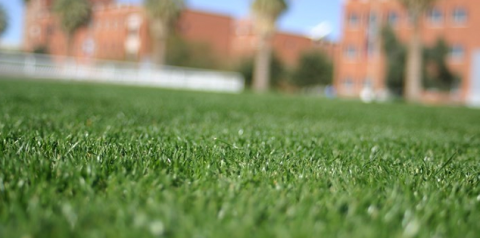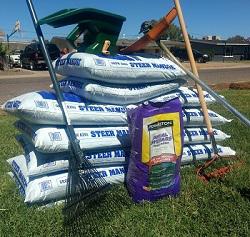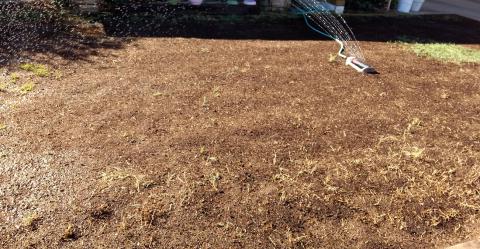Overseeding Bermudagrass Lawns with Annual Ryegrass
University of Arizona Pinal County Cooperative Extension

If you want a spot of green lawn in your yard during the coming winter months, early October is the best time to switch your heat-loving summer lawn to a cool weather grass by overseeding.
A little patch of lawn is considered to be okay in low water-use landscapes, but there currently is no available lawn turf that will stay green and growing year round. In the summer, Bermudagrass hybrids grow well and are generally hardy, but they go dormant during the winter months. On the other hand, winter grasses, like annual and perennial ryegrass, cannot take the heat and dry of our summers.
To solve this problem, many turf managers choose to overseed the hardy Bermuda with winter grasses to keep lawns green and looking good through the winter. Then, in the spring, the winter grasses are scalped back so that the Bermuda can begin to grow uninhibited. The annual ritual of converting all forms of Bermudagrass and other warm weather lawns to a winter-hardy grass will soon be in full swing throughout the desert areas of Arizona. The conversion process is fairly easy to do, as long as a few simple rules are followed.
If overseeding seems right for you, now is the time to start getting ready. The warm temperatures of late September and early October are ideal for overseeding. If you wait until November, the cooler temperatures may slow the germination of the new seed and leave a skimpy, uneven lawn. The patches of bare ground scattered through the seeded area can be quite unsightly. Early October provides excellent temperatures for good germination and growth of the young seedling plants.
The winter grass to plant is ryegrass. You have your choice of either annual or perennial rye. Annual ryegrass seed is fairly inexpensive and germinates well. The grass will stay green well into the spring, only dying out when the heat of June arrives.
One of the benefits of planting perennial ryegrass is that, in milder climates, it will persist through the year from season to season. Because of the high summer temperatures in Pinal County, perennial ryegrass will usually die out completely, except in the shade, thus losing its primary benefit. Perennial ryegrass seed is also more expensive than annual ryegrass seed. The real benefit to perennial over annual ryegrass is that perennial forms have a leaf structure that is more fine and less coarse rather than the tall and lanky-growing annual ryegrass. In short, many people feel that perennial ryegrass makes a better looking turf than the annual forms. It is your choice.
When preparing to plant annual ryegrass, it is important to remember that the heat-loving Bermudagrass will most likely still be green at the first of October. In order to ensure proper seed contact with the soil, it will be necessary to thin out the summer grass growth. This is most-easily done by lowering the lawn mower blades gradually until you have scalped the lawn area close to ground level. It is important to remove all grass clippings. If a grass catcher was not used, it will be necessary to rake the area with a flexible leaf rake and remove the litter.
The next step is to apply ryegrass seed over the relatively bare surface at the rate of one- to one-and-one-half pounds of seed per 100 square feet. Distribute the seed evenly by hand or with a lawn seeder. Overlap seeded areas to be sure of complete coverage. You can be sure, of course, that this procedure will be watched with interest by every bird in the neighborhood.
After seeding is completed, apply manure or some other organic mulch to lightly cover the seeds. The mulch will help hide the seed from the birds and also help keep the seeds moist between irrigation. The mulch should be evenly distributed to a depth of about one-fourth inch thick over the entire area.

It is critical to keep the seed moist until it has germinated and has developed a root system capable of picking up sufficient water to meet the plant's needs. Set the sprinkler to wet the entire lawn area. For best seed germination, apply light irrigations to the seeded area several times during the day, especially during the warmer parts of the day. The germinating seed must not be allowed to dry out during this stage or it will die. If water accumulates on the surface of the soil, it is okay to turn off the sprinkler temporarily, but do not forget to keep an eye on the seed and water again as necessary.

Water accumulating on the soil surface is bad because it may float out the rye seed and expose it to the air, birds, or drying temperatures. Sometimes it will wash the seed into lower lying areas causing an uneven stand. When the water disappears from the soil surface, and the surface of the mulch begins to dry, be sure to start the sprinklers again. Scratch the surface to make sure water has penetrated the manure covering and has thoroughly wet the seed surface.
After the seed has germinated and the area has a green cast, the frequency of irrigation can be cut back to once each day or once every other day. If wilting of the new grass seedlings becomes evident, be sure to water immediately!
The new lawn should be first mowed only when the entire area is approximately two to three inches tall. Use a sharp mower and remove the clippings during the first mowing. Set the mower to cut at one and one-half to two inches above ground level and repeat the mowing when the grass grows about one inch above the set level.
It generally takes about two weeks to get a good stand of annual ryegrass in the fall, so patience and diligent care are essential.
The transition back to summer grass in the spring is much more simple than the fall transition. Simply scalp back the annual ryegrass with the mower in May or early June (whenever the nighttime temperatures reach 60° F. on a regular basis) and deep irrigate the lawn. Soon the Bermudagrass will start growing again.
With a little advance planning and an eye for detail, beautiful, deep green winter lawns are possible throughout the desert regions of Arizona.

